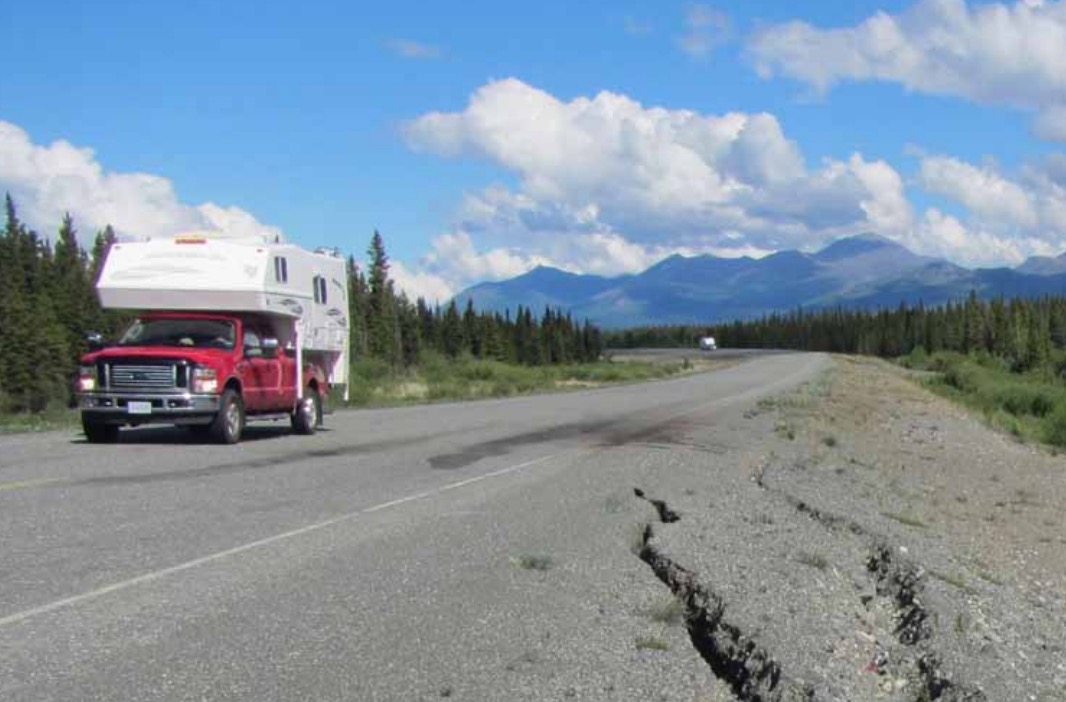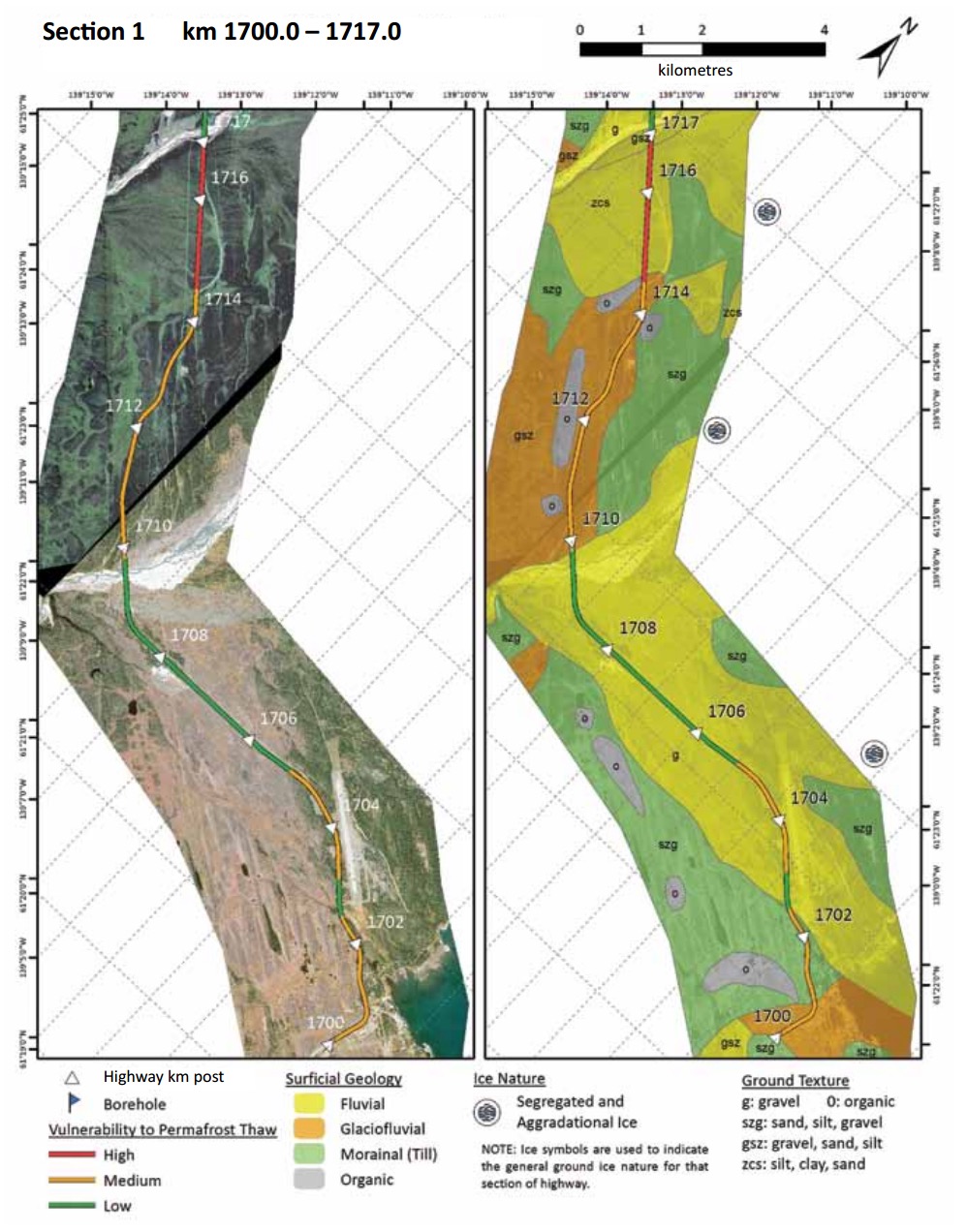NORTHERN CLIMATE EXCHANGE
1. Introduction
 Yukon, Alaska and northern British Columbia depend heavily on road transportation to link communities and connect industrial activities to international markets. The Alaska Highway is the central transportation corridor in Yukon. It is crucial to maintaining and expanding economic development, the quality of life of the population and international ties.
Yukon, Alaska and northern British Columbia depend heavily on road transportation to link communities and connect industrial activities to international markets. The Alaska Highway is the central transportation corridor in Yukon. It is crucial to maintaining and expanding economic development, the quality of life of the population and international ties.
In the context of current and anticipated climate change, permafrost temperature has warmed significantly in northern territories and is expected to continue to rise (SNAP 2014). The stability of northern transportation infrastructure may be compromised by changes in permafrost, particularly in areas where the soil contains large amounts of ice. This may lead to negative impacts on economic development, including increasing the complexity and cost of road maintenance and the price of shipping goods in the North.
This report can be used to support decisions regarding road maintenance and future measures to mitigate permafrost thaw. Northern Climate ExChange (NCE) has partnered with Yukon’s Highways and Public Works (HPW) to assess the vulnerability of the Alaska Highway to permafrost thaw along a 200-km section between Burwash Landing and the Yukon/Alaska border. Since its construction, this section of highway has been affected by permafrost thaw. The communities of Burwash Landing and Beaver Creek, as well as the traditional territories of White River First Nation and Kluane First Nation, are adjacent to the highway. All the people in the area depend on reliable access to transportation infrastructure to support their livelihoods.
1.1 Context
The Alaska Highway between Burwash Landing and the Yukon/Alaska border is underlain by extensive discontinuous, warm and frequently ice-rich permafrost. The disturbance caused by construction of the road and climate warming has already led to the thawing of permafrost, which has had an impact on the road. Some sections of the highway have experienced longitudinal cracking, embankment failure, differential settlement and even complete collapse.
There is considerable variation in local topographic and environmental conditions (e.g., air temperature, geology, surficial soil deposits, soil water and ice content) along the Alaska Highway. This makes it difficult to predict precisely how sections of the highway will respond to variability and change in climate. These are the general characteristics of this section of the highway:
- The section of the road being assessed extends from 60°45’N to 62°37’N.
- The region is part of the Cordilleran Orogeny geological class. This includes various mountain belts with elevations that range from 250 metres above sea level (masl) in the Yukon River to higher than 5000 masl in the St. Elias Mountains.
- The highway crosses heterogeneous soil surface deposits, ranging from very fine sediments to very coarse sediments such as gravel, pebble and cobble. Their origins are glacial (Pliocene to Early Pleistocene), postglacial (late Pleistocene) and recent (Holocene).
- Many parts of the highway cross warm permafrost, where the ground temperature is close to 0°C. Current permafrost temperatures are the combined result of previous climate conditions, construction activities and changes in surficial conditions.
- The current climate of the region is mainly subarctic continental, varying slightly with elevation and mountainside orientation. Winters tend to be long and cold, and summers short and warm. Precipitation in both winter and summer is limited: less than 400 mm per year.
- Projected increases of mean annual air temperature (MAAT) range from 1°C to 3°C of warming by 2050, depending on the success of efforts to reduce greenhouse gas emissions (SNAP 2014).
Because of this complex environment, the report uses multiple sources of data and a combination of methods to interpret permafrost vulnerability and anticipate future conditions. Geophysical data, previous geotechnical reports, HPW maintenance records, surficial geology maps, satellite photos and other available information were combined with field investigation and laboratory soil testing to investigate the thaw sensitivity of the permafrost that underlies the highway.
The report provides descriptions of permafrost characteristics underneath the highway on a section-by-section basis. It has been created for a broad range of users, including community members, decision-makers, civil engineers and road maintenance workers.
Download full version (PDF): Vulnerability of the North Alaska Highway to Permafrost Thaw
About the Northern Climate ExChange
www.yukoncollege.yk.ca/research/programs/northern_climate_exchange
Established in 2000, the Northern Climate ExChange (NCE) focuses on the study of climate change in Yukon by (1) promoting and conducting research on impacts and adaptations across Canada’s North, (2) coordinating the exchange of scientific and local knowledge and expertise, and (3) providing mainstreaming and decision-making support, policy alternatives, and climate change education for a wide range of partners and audiences.
Tags: AK, Alaska, Northern Climate ExChange, Permafrost, Yukon College







 RSS Feed
RSS Feed